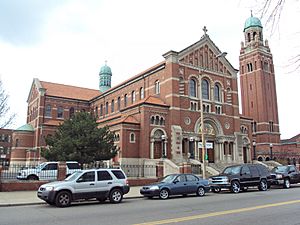History of Mexican Americans in Metro Detroit facts for kids
This article is about the history and culture of Mexican and Mexican American people in the Detroit area, also known as Metro Detroit. In 2004, more than half of the Hispanic people living in the Wayne, Macomb, and Oakland counties were of Mexican heritage.
Contents
Mexican Community Growth in Detroit
In 1910, there were fewer than 100 Mexicans in the entire state of Michigan. Many of the first Mexicans who came to Detroit in the 20th century were from central Mexico. They moved to Detroit to find jobs in factories. Some even worked for Henry Ford, earning $5 a day, which was a lot of money back then!
A neighborhood called Mexicantown was created to offer Mexican goods and services. It was first known as "La Bagley." Even though the U.S. Census in 1920 only counted 1,268 Mexicans in Michigan, historians believe there were actually over 4,000 Mexicans just in Detroit.
By 1951, Detroit had a large Mexican community. There were about 15,000 to 17,000 people of Mexican heritage who were born in the U.S. Also, about 12,000 people born in Mexico lived there. As time went on, more and more Mexican Americans were born in Michigan. This helped the Mexican community in Metro Detroit grow even bigger in the 1950s and 1960s.
Who Lives in Metro Detroit?
In 2014, there were 22,700 Mexican immigrants in Wayne County. This made Mexicans the largest group of immigrants in that county. Across all of Metro Detroit, Mexicans are the third-largest immigrant group. In Macomb and Oakland counties, Mexicans are also one of the top ten largest immigrant groups.
Jobs and Work
During the 1950s and 1960s, many second and third-generation Mexican Americans worked in important industries. They often found jobs in steel foundries, steel factories, and car manufacturing plants. These jobs were a big part of the economy in Detroit.
News and Media
For a while, there were Spanish-language newspapers in Michigan.
- In 1954, Jose R. Flores started a newspaper called El Informador. It closed in 1956.
- After that, Jose Flores bought another paper called El Atomo and changed its name to Noticias (which means "News").
- In 1958, a teacher named Jose Elisandro started Ecos de Michigan ("Echoes from Michigan"). Noticias closed when Ecos opened.
- Six months later, El Heraldo ("The Herald") opened, and Ecos closed. El Heraldo then closed in 1961.
After 1961, there were no Spanish-language newspapers based in Michigan. So, Mexicans in the area read newspapers from other states. Some of these included El Diaro, Excelsior, El Informador, Iniversal, El Norte, Novedades, La Opinión, and La Prensa.
Community Groups
Many groups were created to help the Mexican community in the past. These were called mutual aid societies. Some of them included Los Caballeros Catolicos and the VFW Mexican American Post #505. In 1960, a youth group called Club Camellia was started. In 1961, the Comite de Festejos Guadalupanos ("Committee of Guadalupe Parties") was also founded. These groups helped people connect and support each other.
Faith and Religion

Many Mexicans and Mexican Americans began going to Holy Redeemer Catholic Church in Mexicantown starting in 1955. In the same year, the Primera Iglesia Bautista Mexicana ("First Baptist Mexican Church") opened. By 1960, this church had 200 families as members. This church also started a branch of the Lincoln Park Baptist Church, called the Primera Iglesia Bautista del Sur (First Baptist Church of the South).
By 1960, the Holy Redeemer Elementary School had 200 Mexican students out of 1,200 total students. By 1961, the Holy Redeemer church started offering a special mass in Spanish, and about 500 Mexican churchgoers attended.
In the 1950s and 1960s, other churches that Mexican Americans and Mexicans often went to included All Saints Church, Holy Cross Church in Delray, Most Holy Trinity, St. Anne's, St. Anthony, St. Boniface, St. Leo, and St. Vincent.
Fun and Culture
Detroit also had a Mexican radio hour! Javier Cardenas, who was from Guadalajara, started a Spanish-language radio show in October 1952. It aired for one hour every Saturday and Sunday on WPON. The show moved to WPAG in January 1955, and then to WHRV in 1958. In 1961, Cardenas began directing and producing a Sunday-only show for WQTE, which aired from 10:00 AM to 11:30 AM. This radio program stopped airing in 1980.
There were also dancing and music groups like "Club Fiesta," "Most Holy Trinity Dancing Club," and "Club Artistico Pemamino." At that time, there were no sports clubs specifically for the Mexican community.
In 1961, the Alamo Theater opened. It was the first movie theater in Detroit to show Spanish-language films.

